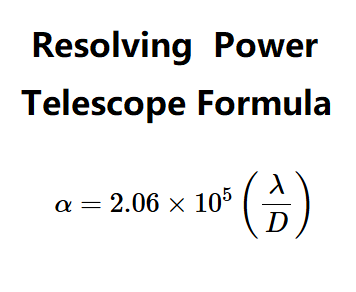 Home
Home
 Back
Back

Definition: The resolving power of a telescope is the minimum angular separation at which two point sources can be distinguished, calculated using the formula:
Variables:
Details: Resolving power is critical in astronomy and optics for determining the clarity and detail a telescope can provide, influencing the design of telescopes for observing planets, stars, and other celestial objects.
Tips: Enter the wavelength (in nanometers) and the diameter (in meters). Click "Calculate" to get the resolving power in multiple angular units: radians, degrees, grades, arcminutes, arcseconds, and revolutions. Values less than 0.0001 will be displayed in scientific notation.
Q1: What is resolving power?
A: Resolving power is the ability of a telescope to distinguish two closely spaced objects as separate entities.
Q2: Why is wavelength important?
A: The wavelength of light affects resolution; shorter wavelengths allow for better resolution.
Q3: What does the diameter represent?
A: The diameter is the size of the telescope's aperture, which collects light and impacts its resolving power.
Q4: What are the different angular units?
A: The calculator provides the result in radians (rad), degrees (°), grades (grad), arcminutes ('), arcseconds ("), and revolutions (rev). Arcseconds are commonly used for telescope resolution.
Q5: How accurate is this calculator?
A: The calculator is accurate based on the given formula and input values, assuming ideal conditions. Real-world factors like atmospheric distortion may affect actual resolution.